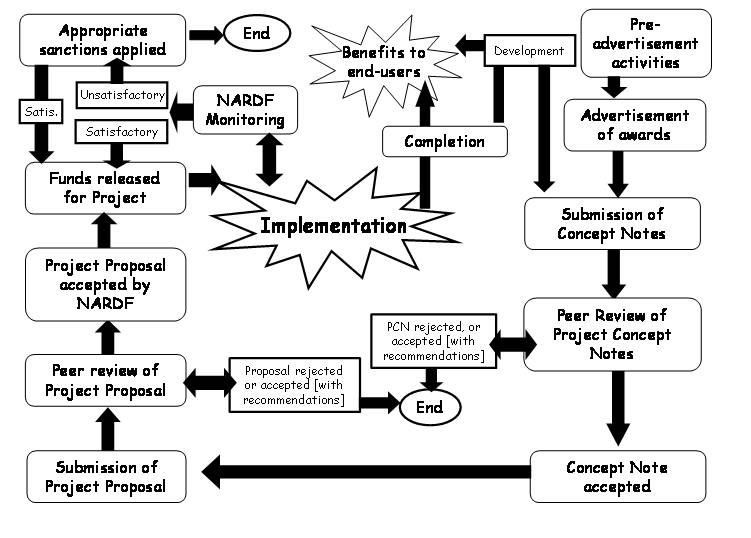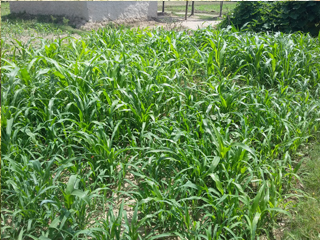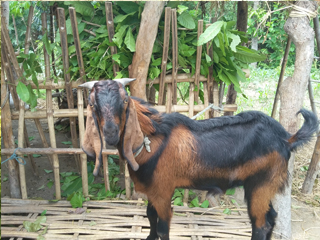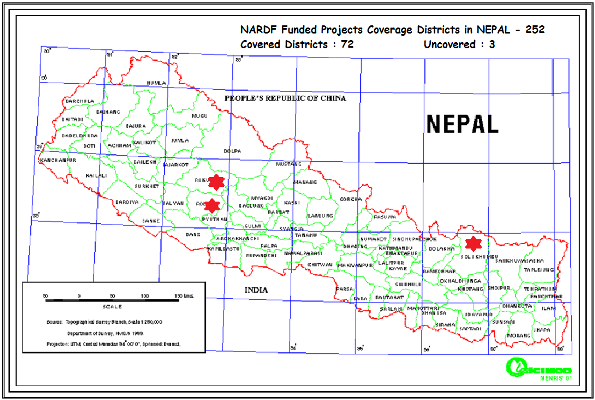छनोट प्रक्रिया र मापदण्ड




1. Calls for Project Concept Notes [PCN] are published on national daily newspaper and URL www.nardf.org.np at least annually as deemed appropriate by the FMC. The steps for selection are shown in figure 3 above.
2. PCNs should be prepared according to NARDF guidelines, and submitted to the NARDF Secretariat formally by the lead organization. It is important to mention that the PCN needs to be concise and specific.
3. The PCN should be accompanied with Organizational Profile indicating staffs and their qualifications, aims and objectives, budget, project work experience and any current activities including legal documents of leading and collaborating organization.
4. Each PCN will be pre-screened by the NARDF Secretariat to ensure that the PCN meets the criteria as set hereunder:
a. The PCN must be within one of the priority areas (identified by the FMC) and announced in the call.
b. The PCN must be presented in the NARDF formats given in Chapter 3.
c. The PCN must be accompanied by a logical framework as described in Annex 1.
d. A single PCN cannot be submitted as more than one PCN under different headings or locations or any other makeup.
e. Along with the PCN, the applicant must produce a recent Memorandum of Understanding (MOU) of the collaborating local and/or national institution(s) as demanded by the nature of the project.
f. The PCN must be accompanied with updated and signed Resume (as in Annex 2) of the Project Coordinator (Minimum qualification Bachelor Level). The education and experience of the Project Coordinator must be directly related to the proposed PCN. NARDF secretariat can verify the authenticity of the information provided in the Resume.
g. The project team composition must be presented with the names of the experts (as described in Chapter 3).
h. A Project Coordinator cannot submit more than one PCN in one call. Similarly, an expert cannot be a member of more than two teams in one call. However, the Project Coordinator of one team can be a member of one additional team.
i. A Project Coordinator who is handling two or more uncompleted projects awarded by NARDF cannot submit a PCN.
j. For specific Donor Funded projects, if any, the conditions of the donors as specified in the call should be fully met.
k. PCN must be submitted with Organizational profile, CV of project co- ordinator.
5. Any PCN that does not meet any of the conditions specified above in No 4 (a through k) get rejected automatically. In such case the applicant will be notified accordingly.
6. Each PCN that passes the pre-screening is double coded with a unique reference number for anonymity prior sending to reviewers.
7. Each coded anonymous copy of PCN is sent to three independent peer reviewers for evaluation as per the set criteria for selection.
8. After reviewing the PCNs the peer reviewers must submit their confidential report to NARDF stating whether the PCN can be:
A. Accepted provided the recommended minor changes [with reasons] are incorporated by the applicant; or
B. Accepted provided the recommended moderate changes [with reasons] are incorporated by the applicant; or
C. Rejected, indicating the reasons for the rejection.
9. While identifying a Peer Reviewer for a particular PCN, the NARDF secretariat will consider the relevancy of the expertise, and past performance, particularly, the timely submission of the review reports and the quality of the technical inputs provided by the Reviewer.
10. Applicants of successful PCNs are invited to submit Full Project Proposals.
SELECTION PROCESS FOR FULL PROJECT PROPOSAL
11. Full Project Proposals (FPP) shall be prepared according to the guidelines given in this Manual [Chapter 4] and the recommendations of the PCN reviewers, if any. It should be noted that an invitation to submit a Full Project Proposal is not a guarantee that the proposal will be accepted.
12. Each FPP will be pre-screened by the NARDF Secretariat to ensure that the criteria as set here under have been met:
a. The FPP must be presented in the formats as given in Chapter 4.
b. The FPP must be accompanied by a logical framework as described in Annex 1.
c. The FPP must be accompanied by a signed and dated Resume (as in Annex 2) of coordinator (minimum qualification of Bachelor) and each of the Team member. The qualification and experience of each of the team member must be directly related to the role and responsibilities assigned to her/him. NARDF can verify the authenticity of the information provided in the Resume.
d. The budget shares including that of each of the collaborators should be clearly spelt out.
13. Any FPP that does not meet any of the conditions set in No 12 get rejected automatically. In such case the applicant will be notified accordingly.
14. Each FPP that passes the pre-screening is double coded with a unique reference number for anonymity prior sending to peer reviewers.
15. Each coded anonymous copy of FPP is sent to three independent peer reviewers for evaluation as per the set criteria.
16. After reviewing the FPP the peer reviewers submit their confidential report to NARDF stating whether the FPP can be:
A. Accepted provided the recommended minor changes [with reasons] are incorporated by the applicant; or
B. Accepted provided the recommended moderate changes [with reasons] are incorporated by the applicant; or
C. Rejected, indicating the reasons for the rejection.
17. While identifying a Peer Reviewer for a particular FPP, the NARDF secretariat will consider the relevancy of the expertise, and past performance, particularly, the timely submission of the review reports and the quality of the technical inputs provided by the Reviewer.
18. The Secretariat collects the responses from all peer reviewers and submits the same to the Technical Sub-Committee (TSC).
19. The TSC goes through the proposal and reviewer's comments and scrutinizes the proposals. The TSC then selects the projects based on the following criteria in order:
a. Relevancy of the proposal to the priority areas specified in the call
b. Soundness of the methodology to address the problems identified
c. Composition of the team and their relevancy to the proposed project
d. Clarity on the contributions of each team member and collaborating institutions
e. Strengths and relevancy of the Resume of the Project Coordinator and each of the members to the proposed work.
20. The TSC recommends the prioritized projects to the FMC.
21. The recommended proposals are accepted and approved by the FMC on the basis of
a. Urgency of the problem to be addressed
b. Availability of the funds
c. Past performance and credibility of the organization and the proponent.
d. Equity among the institutions, regions and disciplines.
22. If the FMC finds the project worth pursuing, it will direct the TSC/ NARDF secretariat to negotiate and make agreement with the proponent on technical improvement and financial matters.
23. The TSC negotiates with the proponent as given in Chapter-7 on the matters specified by the FMC and asks the proponent to revise the proposal and re-submit within a specified period. The TSC may invite related experts to clarify some technical matters.
24. The TSC re-evaluates the proposal on the basis of the following
a. Satisfactory revisions of the proposal
b. Strength and credibility of the organization
c. Status and progress of the projects earlier granted by NARDF, if any
25.Once the TSC is satisfied from the proposal and proponent on above criteria, it recommends to the secretariat for agreement.
26. TSC reserves the right to terminate negotiations at any time and recommend rejecting the proposal in the event of inadequate progress in negotiations.
Once the projects are approved by the FMC for funding and upon successful negotiations by the TSC, the NARDF secretariat invites the proponent to sign an agreement within the time specified.











